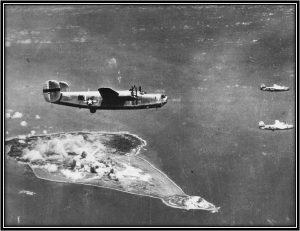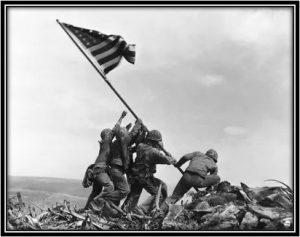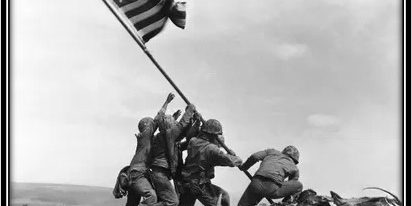On This Day in Aviation History: Iwo Jima
Contributor: Barry Fetzer
Sources: History.com
When we think about Iwo Jima, we typically (and rightfully) think about the USMC infantry that slogged their way through horrific battle conditions to wrest the island from the hands of its Japanese defenders, with tragic consequences for those killed and wounded, casualty numbers that were—and are—unfathomable.
But aviation had role, too, in this historic battle, admittedly a small one compared to what Marine infantry had to endure. Seventy-nine years ago today in 1945, according to History.com, “the west Pacific volcanic island of Iwo Jima was declared secured by the U.S. military after weeks of fiercely fighting its Japanese defenders.

B-24 Liberators of the 30th Bomb Group, 819th Bomb Squadron fly over Iwo Jima on 15 February 1945. Courtesy Pinterest.
“The Americans began applying pressure to the Japanese defense of Iwo Jima in February 1944, when B-24 and B-25 bombers raided the island for 74 days straight. It was the longest pre-invasion bombardment of the war, necessary because of the extent to which the Japanese–21,000 strong–fortified the island, above and below ground, including a network of caves.
“Underwater demolition teams (“frogmen”) were dispatched by the Americans just before the actual invasion to clear the shores of mines and any other obstacles that could obstruct an invading force. In fact, the Japanese mistook the frogmen for an invasion force and killed 170 of them.
“The amphibious landings of Marines began the morning of February 19, 1945, as the secretary of the Navy, James Forrestal, accompanied by journalists, surveyed the scene from a command ship offshore. The Marines made their way onto the island–and seven Japanese battalions opened fire, obliterating them. By that evening, more than 550 Marines were dead and more than 1,800 were wounded.
“In the face of such fierce counterattack, the Americans reconciled themselves to the fact that Iwo Jima could be taken only one yard at a time. A key position on the island was Mt. Suribachi, the center of the Japanese defense. The 28th Marine Regiment closed in and around the base of the volcanic mountain at the rate of 400 yards per day, employing flamethrowers, grenades, and demolition charges against the Japanese that were hidden in caves and pillboxes (low concrete emplacements for machine-gun nests). Approximately 40 Marines finally began a climb up the volcanic ash mountain, which was smoking from the constant bombardment, and at 10 a.m. on February 23, a half-dozen Marines raised an American flag at its peak, using a pipe as a flag post. Two photographers caught a restaging of the flag raising for posterity, creating one of the most reproduced images of the war. With Mt. Suribachi claimed, one-third of Iwo Jima was under American control.
 “Uncommon valor was a common virtue.”
“Uncommon valor was a common virtue.”
“On March 14, the U.S. announced its occupation of the island, but fighting didn’t cease for almost two more weeks. On March 26, with a U.S. Navy military government established, Iwo Jima was declared secured. When all was done, more than 6,000 Marines died fighting for the island, along with almost all the 21,000 Japanese soldiers trying to defend it.”







